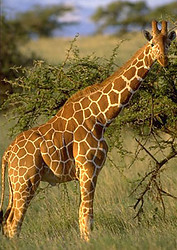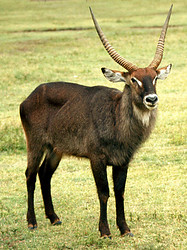Ruminantia
Ruminants



This tree diagram shows the relationships between several groups of organisms.
The root of the current tree connects the organisms featured in this tree to their containing group and the rest of the Tree of Life. The basal branching point in the tree represents the ancestor of the other groups in the tree. This ancestor diversified over time into several descendent subgroups, which are represented as internal nodes and terminal taxa to the right.

You can click on the root to travel down the Tree of Life all the way to the root of all Life, and you can click on the names of descendent subgroups to travel up the Tree of Life all the way to individual species.
For more information on ToL tree formatting, please see Interpreting the Tree or Classification. To learn more about phylogenetic trees, please visit our Phylogenetic Biology pages.
close boxReferences
Allard, M. W., M. M. Miyamoto, L. Jarecki, F. Kraus, and M. R. Tennant 1992. DNA systematics and evolution of the artiodactyl family Bovidae. Proceedings of the National Academy of Sciences (USA) 89:3972-3976.
Bubenik, G. A. and A. B. Bubenik, eds. 1990. Horns, Pronghorns, and Antlers. Springer-Verlag, New York.
Chikuni, K., Y. Mori, T. Tabata. M. Saito, M. Monma, and M. Kosugiyama. 1995. Molecular phylogeny based on the kappa-casein and cytochrome b sequences in the mammalian suborder ruminantia. Journal of Molecular Evolution 41:859-866.
Cronin, M. A., R. Stuart, B. J. Pierson, and J. C. Patton. 1996. K-casein gene phylogeny of higher ruminants (Pecora, Artiodactyla). Molecular Phylogenetics and Evolution 6:295-311.
DeMiguel, D., M. Fortelius, B. Azanza and J. Morales. 2008. Ancestral feeding state of ruminants reconsidered: earliest grazing adaptation claims a mixed condition for Cervidae. BMC Evolutionary Biology 8:13. doi:10.1186/1471-2148-8-13
Fernández, M. H. and E. S. Vrba. 2005. A complete estimate of the phylogenetic relationships in Ruminantia: a dated species-level supertree of the extant ruminants. Biological Reviews 80(2):269-302.
Gentry, A. W. 1994. The Miocene differentiation of Old World pecora (Mammalia). Historical Biology 7:115-158.
Gentry, A. W. 2000. The ruminant radiation. Pages 11-25 in Antelopes, Deer, and Relatives. E. S. Vrba and G. B. Schaller, eds. Yale University Press, New Haven.
Gentry, A. W. and E. P. J. Heizmann. 1996. Miocene ruminants of the central and eastern Tethys and Paratethys. Pages 378-391 in The Evolution of Western Eurasian Neogene Mammal Faunas. R. L. Bernor, V. Fahlbusch and H.-W. Mittmann, eds. Columbia University Press, New York.
Gentry, A. W., G. Rössner, and E. P. J. Heizmann. 1999. Suborder Ruminantia. Pages 225-258 in The Miocene Land Mammals of Europe. G. Rössner and K. Heissig, eds. Verlag Dr. Friedrich Pfeil, München.
Guhaa, S., S.P. Goyalb and V.K. Kashyap. 2007. Molecular phylogeny of musk deer: A genomic view with mitochondrial 16S rRNA and cytochrome b gene. Molecular Phylogenetics and Evolution 42(3):585-597.
Hassanin, A. and E. J. P. Douzery. 2003. Molecular and morphological phylogenies of Ruminantia and the alternative position of the Moschidae. Systematic Biology 52 (2):206-228.
Janis, C. M. 1982. Evolution of horns in ungulates: ecology and paleoecology. Biological Reviews 57:261-318.
Janis, C. M. 1987. Grades and clades in hornless ruminant evolution: the reality of the Gelocidae and the systematic position of Lophiomeryx and Bachitherium. Journal of Vertebrate Paleontology 7:200-216.
Janis, C. M. 2000. The endemic ruminants of the Neogene of North America. Pages 26-37 in Antelopes, Deer, and Relatives. E. S. Vrba and G. B. Schaller, eds. Yale University Press, New Haven.
Janis, C. M. and E. Manning. 1998. Dromomerycidae. Pages 477-490 in Evolution of Tertiary Mammals of North America C. M. Janis, K. M. Scott and L. L. Jacobs, eds. Cambridge University Press, Cambridge.
Janis, C. M. and K. M. Scott. 1987. The origin of the higher ruminant families with special reference to the origin of Cervoidea and relationships within the Cervoidea. American Museum Novitates 2893:1-85.
Kraus,F. and M. M. Miyamoto. 1991. Rapid cladogenesis among the pecoran ruminants: evidence from mitochondrial DNA sequences. Systematic Zoology 40:117-130.
Leinders, J. J. M. 1983. Hoplitomerycidae fam. nov. (Ruminantia, Mammalia) from Neogene fissure fillings in Gargano (Italy). Part 1: the cranial osteology of Hoplitomeryx gen. nov. and a discussion on the classification of pecoran families. Scripta Geologica 70:1-51.
Leinders, J. J. M. and E. Heintz. 1980. The configuration of the lacrimal orifices in pecorans and tragulids (Artiodactyla, Mammalia) and its significance for the distinction between Bovidae and Cervidae. Beaufortia 30:155-162.
Mahon, A. 2004. A molecular supertree of the Artiodactyla. Pages 411-437 in Phylogenetic Supertrees: Combining Information to Reveal the Tree of Life. O. R. P. Bininda-Emonds), ed. Kluwer Academic Publishers, Dordrecht.
McKenna, M. C. and S. K. Bell. 1997. Classification of Mammals Above the Species Level. Columbia University Press, New York.
Métais, G. 2006. New basal selenodont artiodactyls from the Pondaung Formation (late middle Eocene, Myanmar) and the phylogenetic relationships of early ruminants. Annals of the Carnegie Museum 75(1):51-67.
Métais, G., P.-O. Antoine, L. Marivaux, J.-L. Welcomme, and S. Ducrocq. 2003. New artiodactyl ruminant mammal from the late Oligocene of Pakistan. Acta Palaeontologica Polonica 48 (3):375-382.
Métais, G., Y. Chaimanee, J.-J. Jaeger, and S. Ducrocq. 2001. New remains of primitive ruminants from Thailand: evidence of the early evolution of the Ruminantia in Asia. Zoologica Scripta 30:231-248.
Pérez-Barbería, F. J. and I. J. Gordon. 1999. The relative roles of phylogeny, body size an feeding style on the activity time of temperate ruminants : a reanalysis. Oecologia 120:193-197.
Pérez-Barbería, F. J., I. J. Gordon, and A. W. Illius. 2001. Phylogenetic analysis of stomach adaptation in digestive strategies in African ruminants. Oecologia 129:498-508.
Price, S. A., O. R. P. Bininda-Emonds, and J. L. Gittleman. 2005. A complete phylogeny of the whales, dolphins and even-toed hoofed mammals (Cetartiodactyla). Biological Reviews 80(3):445 - 473.
Roberts, S. C. 1996. The evolution of hornedness in female ruminants. Behaviour 133:399-442.
Scott, K. M. and C. M. Janis. 1993. Relationships of the Ruminantia (Artiodactyla) and an analysis of the characters used in ruminant taxonomy. Pages 282-302 in Mammal Phylogeny. Volume 2. Placentals. F. S. Szalay, M. J. Novacek, and M. C. McKenna, eds. Springer Verlag, New York.
Su, B., Y.-X. Wang, H. Lan, W. Wang, and Y. Zhang. 1999. Phylogenetic study of complete cytochrome b genes in musk deer (genus Moschus) using museum samples. Molecular Phylogenetics and Evolution 12:241-249.
Vrba,E.S . and G. B. Schaller, eds. 2000 . Antelopes, Deer, and Relatives. Yale University Press, New Haven.
Webb, S. D. and B. E. Taylor. 1980. The phylogeny of hornless ruminants and a description of the cranium of Archaeomeryx. Bulletin of the American Museum of Natural History 167:117-158.
Title Illustrations

| Scientific Name | Giraffa camelopardalis reticulata |
|---|---|
| Location | Samburu National Park (Kenya) |
| Creator | Gerald and Buff Corsi |
| Specimen Condition | Live Specimen |
| Source Collection | CalPhotos |
| Copyright |
© 1999 California Academy of Sciences

|
| Scientific Name | Kobus ellipsiprymnus |
|---|---|
| Location | East Africa |
| Comments | waterbuck |
| Acknowledgements | Photograph courtesy InsectImages.org (#4321001) |
| Specimen Condition | Live Specimen |
| Sex | Male |
| Life Cycle Stage | adult |
| Source Collection | Bugwood Network/Forestry Images |
| Copyright | © Kenneth M. Gale |
| Scientific Name | Cervus elaphus |
|---|---|
| Creator | Ed Austin/Herb Jones |
| Specimen Condition | Live Specimen |
| Sex | Male |
| Source Collection | Yellowstone Digital Slide File |
About This Page
Page copyright © 2006
 Page: Tree of Life
Ruminantia. Ruminants.
The TEXT of this page is licensed under the
Creative Commons Attribution-NonCommercial License - Version 3.0. Note that images and other media
featured on this page are each governed by their own license, and they may or may not be available
for reuse. Click on an image or a media link to access the media data window, which provides the
relevant licensing information. For the general terms and conditions of ToL material reuse and
redistribution, please see the Tree of Life Copyright
Policies.
Page: Tree of Life
Ruminantia. Ruminants.
The TEXT of this page is licensed under the
Creative Commons Attribution-NonCommercial License - Version 3.0. Note that images and other media
featured on this page are each governed by their own license, and they may or may not be available
for reuse. Click on an image or a media link to access the media data window, which provides the
relevant licensing information. For the general terms and conditions of ToL material reuse and
redistribution, please see the Tree of Life Copyright
Policies.
- First online 23 February 2006
Citing this page:
Tree of Life Web Project. 2006. Ruminantia. Ruminants. Version 23 February 2006 (temporary). http://tolweb.org/Ruminantia/16001/2006.02.23 in The Tree of Life Web Project, http://tolweb.org/











 Go to quick links
Go to quick search
Go to navigation for this section of the ToL site
Go to detailed links for the ToL site
Go to quick links
Go to quick search
Go to navigation for this section of the ToL site
Go to detailed links for the ToL site